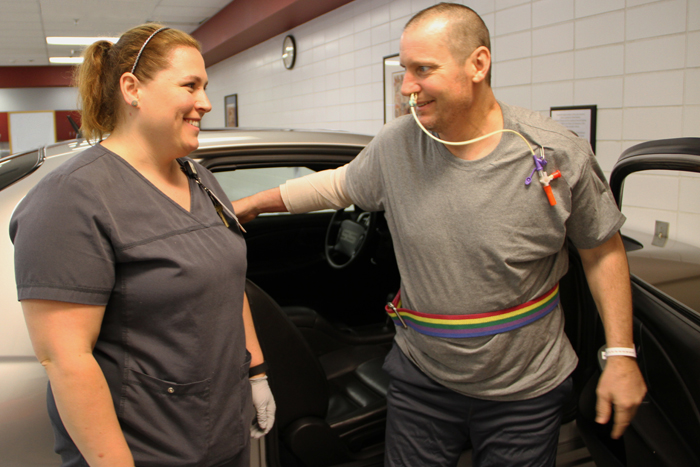The More Severe-Burn Patients Eat, the Faster They Heal (Op-Ed)


Dr. Larry Jones, director of the< a href="http://wexnermedical.osu.edu/patient-care/healthcare-services/burn-care">Comprehensive Burn Center at The Ohio State University Wexner Medical Center, contributed this column to Live Science's Expert Voices: Op-Ed & Insights.
Patients with severe burns, understandably, suffer from substantially diminished appetites because they're in a considerable amount of pain and are often sedated, as a result. So it may seem counterintuitive to ask severely burned patients to consume considerably more calories than they're used to while in the hospital.
Despite these challenges, when burn patients are admitted to the Comprehensive Burn Center at The Ohio State University Wexner Medical Center, we make nutrition a priority, often beginning a feeding tube within 6 hours. It's an aggressive approach that helps burn patients heal faster and recently earned international recognition.
The body's response to severe burns
When someone experiences a severe burn, defined as a second- or third-degree burn that covers at least 20 percent of the body, the hypermetabolic response is extreme. Second- and third-degree burns occur when damage extends beyond the top layer of the skin. With a second-degree burn, the skin blisters and can become extremely red and sore. Third-degree burns are the worst type, extending through every layer of the skin. The damage can even seep into the bloodstream, bones and major organs.
After the body's initial shock response to the injury wears off, metabolism rates can increase up to 180 percent, heart rates can jump by up to 150 percent and the liver can increase in size by up to 200 percent.
In short, the body goes into hyperdrive to heal wounds, and it looks for nutrients wherever it can find them. Unless the patient receives large amounts of supplemental nutrients, the body will rob itself of core nutrients. Essentially, if patients aren't able to meet the high calorie and protein requirements it takes to heal, their body will start consuming its own muscle mass in order to deliver nutrition. Muscle wasting is most obvious in the arms, legs and abdomen.
Get the world’s most fascinating discoveries delivered straight to your inbox.
Once patients lose that muscle mass, their ability to exercise, undergo rehabilitation and fight infection are severely compromised. Doctors need to intervene early in this process to prevent muscle loss and give the patient's body the nutrients it desperately needs to heal.
Feeding the body's efforts to recover
Upon admission to the burn center, patients are evaluated by a dietitian to determine their energy and protein needs. Many are given a feeding tube almost immediately, through which we provide them with up to three to four times the amount of protein they normally receive in a day and 140 percent more calories. Each case is different, of course, so nurses monitor a patient's weight and caloric intake daily and dietitians adjust nutrients as needed.
As a patient's burns heal, they are transitioned to oral meals during the day, with supplemental feedings overnight through the tube. Among other ingredients, the feeding solution contains proteins, which are used by the body to repair and close wounds caused by the burn; glucose, which fuels the healing efforts; vitamin D, which helps modulate cell grown and, along with omega-3 fatty acids, helps control inflammation.
Ingesting such a high volume of calories and supplements can be a challenge. Severe pain is associated with a marked loss of appetite and excessive intake can lead to nausea. When necessary, we may also prescribe patients medication to allow them to tolerate the additional feedings.
Continuing the efforts at home
The healing process continues long after discharge. At a microscopic level, severe burns can take anywhere from a year to 18 months to heal — in some cases, even longer.
My colleagues and I at the burn center are currently studying whether nutritional support should continue after discharge. As patients prepare to leave the burn center, dietitians help develop personalized meal plans for use at home that are high in protein and carbohydrates to stimulate continued healing. When patients return to the burn center for follow-up care for their wounds, we re-evaluate their nutritional status as well.
We'll have to wait to see the extent continued nutritional support may help after discharge, but we've already seen the impact on our patients while they were hospitalized. Aggressive nutritional intervention has been shown to prevent weight and muscle loss and substantially boost immune function.
Recently, we were honored for this approach to treating patients. Critical Care Nutrition at the Clinical Evaluation Research Unit in Ontario, Canada, named the burn team at Ohio State's Comprehensive Burn Center among the "Best of the Best" in its International Nutrition Survey. Ohio State ranked sixth among more than 100 hospitals evaluated worldwide, and the first hospital in the U.S. to rank in the top 10.
Severe burns are among the most painful and physically demanding of any type of injury, so we will continue to look for any advantage we can find for our patients, including making the most of everything they eat.
Follow all of the Expert Voices issues and debates — and become part of the discussion — on Facebook, Twitter and Google+. The views expressed are those of the author and do not necessarily reflect the views of the publisher. This version of the article was originally published on Live Science.




